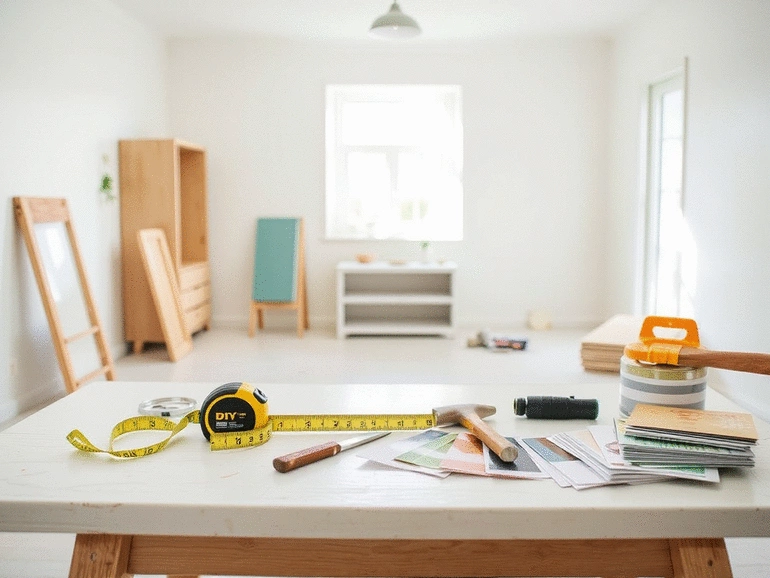DIY Remodeling: Key Aspects
Costs: Material costs, tools/equipment investment, potential waste.
Benefits: Flexibility, personal control, potential cost savings on labor.
Risks: Time-consuming, mistakes, safety concerns, steep learning curve.

When it comes to home remodeling, the decision between DIY and hiring professionals can be daunting. Understanding the full scope of costs involved is essential to making an informed choice. Here's what you will learn:
This visual summarizes the key considerations, including costs, benefits, and risks, when deciding between DIY and professional home remodeling services.
Costs: Material costs, tools/equipment investment, potential waste.
Benefits: Flexibility, personal control, potential cost savings on labor.
Risks: Time-consuming, mistakes, safety concerns, steep learning curve.
Costs: Significant labor fees (20-50%), bundled materials, hidden expenses (permits, disposal).
Benefits: Expertise, quality assurance, efficiency, compliance, peace of mind.
Risks: Higher upfront costs, less control over timeline, contractor selection.
When it comes to home remodeling, one of the first things we often think about is cost. Should I do it myself, or hire a professional? Each option has its own set of expenses that can affect your budget significantly. In this section, we’ll dive deep into the costs associated with both DIY projects and professional services, giving you the insights you need to make an informed decision!
Let’s start by exploring what DIY home remodeling really entails. You might think it’s all about saving money, but there’s more to it than that.
DIY home remodeling means you're taking on the entire project yourself, from planning to execution. This approach allows for greater flexibility and personalized touches, but it often requires a good amount of time and effort. Here’s a closer look at what goes into DIY projects:
Understanding these factors helps you see the full picture when deciding whether to go the DIY route.
When you choose to DIY, you'll primarily bear the cost of materials, which can vary widely depending on the project. For instance, if you're planning a kitchen remodel, materials such as cabinets, countertops, and appliances can quickly become substantial expenses. It's essential to create a detailed budget that accounts for every aspect of the project, including potential unexpected costs. Remember, it’s not just about purchasing materials; think about waste and mistakes that can lead to additional expenses!
Additionally, while you save on labor by doing the work yourself, you need to value your time. Could that time be spent doing something else? Weigh these considerations when calculating your total costs.

With DIY remodeling, having the right tools is crucial. Depending on the complexity of your project, you might need:
Investing in quality tools can not only enhance your work but also ensure your safety while remodeling. If you do decide to take the plunge into DIY, I suggest checking out local home improvement stores for tool rentals. It’s a cost-effective way to access high-quality equipment without breaking the bank!
There’s a wealth of online resources available to help you excel at DIY remodeling. Websites, YouTube channels, and forums can provide you with valuable insights and step-by-step guides. Don’t hesitate to tap into these resources! Here are some tools you might want to utilize:
These resources not only make your project easier but also help you feel more confident about your DIY capabilities!
Now that we’ve covered DIY, let’s look at the other side of the coin: hiring professionals. While this option often comes with a higher price tag, it provides certain advantages that can be worth the investment.
Each of these factors plays a key role in the overall cost of hiring a professional, making it crucial to evaluate all aspects before making your choice.
Labor costs can vary significantly based on the type of work and the contractor’s expertise. Typically, you can expect to pay anywhere from 20% to 50% of the total project cost in labor fees. Keep in mind that while it may seem expensive, hiring a professional can save you time and ensure quality work. When I first remodeled my bathroom, investing in skilled labor saved me countless hours of frustration!
Don’t be afraid to ask for a detailed breakdown of labor costs when getting quotes from contractors. This transparency can help you make a better-informed decision.
In professional remodeling, the cost of materials is often bundled into the overall project cost, but it’s important to ask for clarity on what that includes. Sometimes contractors may upcharge on materials, so doing a little research beforehand can help you negotiate better. Keep an eye out for:
Being aware of these hidden expenses can prevent unpleasant surprises later on. I always recommend having a contingency budget to cover these unexpected costs!

To ensure you’re getting the best value from a contractor, it’s wise to compare multiple quotes. Look for detailed estimates that include the breakdown of labor, materials, and timelines. A lower quote might seem appealing, but it’s important to also consider the contractor’s reputation and past work. You can find more information about evaluating contractor bids and securing fair pricing from resources like HomeGuide's guide on contractor bids and fair pricing, which offers valuable insights into what to look for in an estimate. Taking the time to conduct thorough research and comparisons can ultimately save you money while ensuring your project is completed successfully!
A: For DIY projects, the main costs include materials, tools and equipment, and the value of your time. While you save on labor, you must account for purchasing all necessary supplies and potentially renting specialized tools.
A: You can save money by renting specialized tools from local home improvement stores instead of buying them. This provides access to high-quality equipment without a significant upfront investment.
A: Labor costs in professional remodeling typically range from 20% to 50% of the total project cost, varying based on the complexity of the work and the contractor's expertise.
A: Hidden expenses can include shipping costs for materials, waste disposal fees, and permit costs. Always ask for a detailed breakdown from your contractor and budget for contingencies.
A: Useful resources include online cost calculators (like those from HomeAdvisor or Remodeling Calculator), downloadable budget worksheets, expense tracking apps (e.g., Mint, YNAB), and project management software like Buildertrend or CoConstruct. Additionally, home improvement blogs and video tutorials offer valuable guidance.
When considering a DIY project, always start with a detailed plan and budget. Break down your project into smaller tasks and allocate funds for materials, tools, and unexpected expenses. This proactive approach can save you time and money in the long run, ensuring a smoother remodeling experience!
Deciding whether to go the DIY route or hire a professional can feel overwhelming. At Home Remodeling Insights, I believe that making an informed decision is key to a successful remodeling project! Understanding the tools and resources available can significantly enhance your experience, whether you choose to tackle the project yourself or bring in the experts.
One of the first steps in your remodeling journey is to understand your budget. To help with this, there are several helpful tools you can utilize.
Using these tools can provide clarity and prevent financial surprises as you embark on your project. When it comes to remodeling, knowledge is power!
These resources can be invaluable for learning the ins and outs of your chosen project. They not only inspire confidence but also ensure you're well-prepared!
For those looking to get more precise, estimation software can help you create a detailed budget. Programs like Buildertrend or CoConstruct are designed to provide detailed project estimates, track expenses, and manage schedules—perfect for DIY enthusiasts and professionals alike. By investing time in these tools, you're setting yourself up for a smoother remodeling experience!
As you navigate your remodeling journey, it's vital to keep in mind the costs, benefits, and risks associated with both DIY and professional services. Here are some key takeaways to guide your decision:
Weighing these factors can help you make an informed choice that aligns with your unique situation and project goals.
In the end, the decision between DIY and hiring professionals should reflect your comfort level and project complexity. Take the time to evaluate your skills and resources, and don’t hesitate to seek help when needed!
Finally, make sure to stay updated on the latest trends in home improvement. Trends can influence your project's appeal and value. Keeping an eye on market trends can help you make informed choices that enhance your home’s functionality and aesthetic. Remember, at Home Remodeling Insights, I’m here to provide the guidance you need as you embark on this exciting journey!
Here is a quick recap of the important points discussed in the article:
At Home Remodeling Insights, led by Madeline Birch, we empower homeowners to confidently navigate remodeling decisions by providing clear, practical advice on DIY projects versus hiring professionals. Join us to make your home improvement journey informed and successful.
